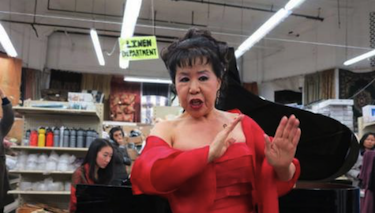Soprano Ok-ja Lim, in Rainer Ganahl's "El Mundo"
In the last hour of yesterday's Sunday stroll through the Lower East Side gallery scene, I stumbled upon a wonderful sub-theme of storefronts and the memories they contain.
Corin Hewitt's "The Third Station" architectural installation at Laurel Gitlen suggests two abandoned storefront facades transformed as funky, dirt encrusted museum-like vitrines. The show feels like a postmortem of a building, the forensic of a facade, in which the the doubling or mirroring of two back-to-back buildings slyly allude to artistic repetition and copying that undermine uniqueness. Encased behind the windows, and presented on columns of pressed dirt, are flattened boxes of HD studio make-up that remind on of fake skin and the merging cycles of life and death.
Rainer Ganahl's "El Mundo" at Kai Matsumiya is a two-projection video presentation based on a classical music concert that took place at El Mundo, a now-defunct discount store that had been functioning in the former Eagle Theater in Spanish Harlem, New York. The concert took place during the discount store's going-out-of-business sale in 2013. As I watched the videos in Ganahl's installation the gallerist noted that 50-years earlier and just a few blocks away Claus Oldenburg had made his legendary Store installation. In December 1961, Oldenburg opened The Store, stocked with items made of painted plaster and chickenwire, in a rented storefront at 107 East Second Street that served as his studio. Writer Jonathon Keats in Forbes called The Store "one of the all-time great Pop Art installations, more subversive even than Andy Warhol's breakthrough exhibition of 32 Campbell's Soup cans in 1962."
Watching Ganahl's "El Mundo," I was struck by the persistence of artists and the arts. Here I was, watching a video performance staged by a conceptual artist working with professional musicians, sponsored in part by the intrepid non-profit White Columns under the leadership of their inimitable director Matthew Higgs; and as I watched the performance Ganahl's camera panned the ceiling of the defunct Harlem store and I spotted a ceiling a fleur-de-lis and instantly realized that the nearly abandoned Harlem store had once been a show palace. And these wonderful performers were standing in a place that had once been filled with artists of previous generations. Viewing that video in a formerly abandoned storefront in the Lower East Side that was being reclaimed and adapted by artists made me think how cities often come full-circle while artists, constantly in danger of being turfed under, remain unsinkable and ready to reinvent and reinvigorate life.
Installation view, Corin Hewitt's "The Third Station," at Laurel Gitlen
Corin Hewitt's "The Third Station"
Now through May 11
Laurel Gitlen
122 Norfolk Street
New York, NY 10002
W. laurelgitlen.com
Hours: Wed-Sun, 11-6
Rainer Ganahl's "El Mundo"
Now through May 24
Kai Matsumiya
153 1/2 Stanton Street
New York, NY 10002
W. kaimatsumiya.com
Hours: Wed-Sun, 12-6


